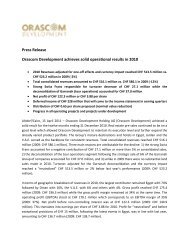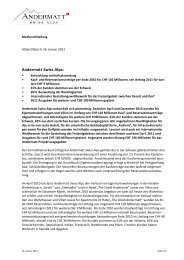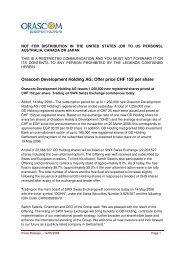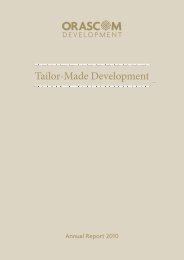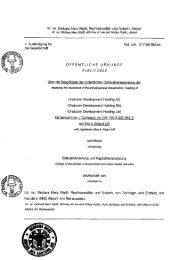FY 2012 Annual Report - Orascom Development
FY 2012 Annual Report - Orascom Development
FY 2012 Annual Report - Orascom Development
Create successful ePaper yourself
Turn your PDF publications into a flip-book with our unique Google optimized e-Paper software.
F-17 <strong>Orascom</strong> <strong>Development</strong> <strong>2012</strong> <strong>Annual</strong> <strong>Report</strong> F-18<br />
3.5 Investment in associates<br />
An associate is an entity over which the Group has significant influence and that is neither a subsidiary nor an interest in a joint<br />
venture. Significant influence is the power to participate in the financial and operating policy decisions of the investee but is not<br />
control or joint control over those policies.<br />
The results, assets and liabilities of associates are incorporated in these consolidated financial statements using the equity method<br />
of accounting, except when the investment is classified as held for sale, in which case it is accounted for in accordance with IFRS 5<br />
Non-current Assets Held for Sale and Discontinued Operations.<br />
Under the equity method, an investment in an associate is initially recognised in the consolidated statement of financial position<br />
at cost and adjusted thereafter to recognise the Group's share of the profit or loss and other comprehensive income of the<br />
associate. When the Group's share of losses of an associate exceeds the Group's interest in that associate (which includes any<br />
long-term interests that, in substance, form part of the Group's net investment in the associate), the Group discontinues<br />
recognising its share of further losses. Additional losses are recognised only to the extent that the Group has incurred legal or<br />
constructive obligations or made payments on behalf of the associate.<br />
Any excess of the cost of acquisition over the Group’s share of the net fair value of the identifiable assets, liabilities and contingent<br />
liabilities of an associate recognised at the date of acquisition is recognised as goodwill, which is included within the carrying<br />
amount of the investment. Any excess of the Group’s share of the net fair value of the identifiable assets, liabilities and contingent<br />
liabilities over the cost of acquisition, after reassessment, is recognised immediately in profit or loss.<br />
The requirements of IAS 39 are applied to determine whether it is necessary to recognise any impairment loss with respect to the<br />
Group’s investment in an associate. When necessary, the entire carrying amount of the investment (including goodwill) is tested<br />
for impairment in accordance with IAS 36 Impairment of Assets as a single asset by comparing its recoverable amount (higher of<br />
value in use and fair value less costs to sell) with its carrying amount. Any impairment loss recognised forms part of the carrying<br />
amount of the investment. Any reversal of that impairment loss is recognised in accordance with IAS 36 to the extent that the<br />
recoverable amount of the investment subsequently increases.<br />
Upon disposal of an associate that results in the Group losing significant influence over that associate, any retained investment is<br />
measured at fair value at that date and the fair value is regarded as its fair value on initial recognition as a financial asset in<br />
accordance with IFRS 9.The difference between the previous carrying amount of the associate attributable to the retained interest<br />
and its fair value is included in the determination of the gain or loss on disposal of the associate. In addition, the Group accounts<br />
for all amounts previously recognised in other comprehensive income in relation to that associate on the same basis as would be<br />
required if that associate had directly disposed of the related assets or liabilities. Therefore, if a gain or loss previously recognised<br />
in other comprehensive income by that associate would be reclassified to profit or loss on the disposal of the related assets or<br />
liabilities, the Group reclassifies the gain or loss from equity to profit or loss (as a reclassification adjustment) when it loses<br />
significant influence over that associate.<br />
When a Group entity transacts with associates of the Group, profits and losses resulting from the transactions with the associate<br />
are recognised in the Group’s consolidated financial statements only to the extent of interests in the associate that are not related<br />
to the Group.<br />
3.6 Goodwill<br />
Goodwill arising on an acquisition of a business is carried at cost as established at the date of acquisition of the business (see note<br />
3.4) less accumulated impairment losses, if any.<br />
For the purposes of impairment testing, goodwill acquired in a business combination is allocated, starting from the acquisition<br />
date, to each of the Group’s cash-generating units (or groups of cash-generating units) that is expected to benefit from the<br />
synergies of the combination. When assessing each unit or group of units to which the goodwill is so allocated, the Group’s<br />
objective is to test goodwill for impairment at a level that reflects the way the Group manages its operations and with which the<br />
goodwill would naturally be associated under the reporting system in place.<br />
A cash-generating unit to which goodwill has been allocated is tested for impairment annually, or more frequently when there is<br />
indication that the unit may be impaired. If the recoverable amount of the cash-generating unit is less than its carrying amount,<br />
the impairment loss is allocated first to reduce the carrying amount of any goodwill allocated to the unit and then to the other<br />
assets of the unit pro-rata based on the carrying amount of each asset in the unit. Any impairment loss for goodwill is recognised<br />
directly in profit or loss in the consolidated statement of comprehensive income. An impairment loss recognised for goodwill is not<br />
reversed in subsequent periods.<br />
On disposal of the relevant cash-generating unit, the attributable amount of goodwill is included in the determination of the profit<br />
or loss on disposal.<br />
The Group’s policy for goodwill arising on the acquisition of an associate is described in note 3.5.<br />
3.7 Revenue recognition<br />
Revenue is measured at the fair value of the consideration received or receivable. Revenue is reduced for estimated customer<br />
returns, rebates and other similar allowances.<br />
Different policies for revenue recognition apply across the Group's business segments. The following table shows the link between<br />
the accounting policies for revenue recognition and segment information.<br />
Accounting policies<br />
3.7.1 Revenue on sale of land Sale of land<br />
Segments classified by type of activity<br />
3.7.2 Revenue from agreements for construction of real estate Real estate and construction<br />
3.7.3 Construction revenue Real estate and construction<br />
3.7.4 Revenue from the rendering of services<br />
Hotels<br />
Destination management<br />
Other operations<br />
3.7.5 Dividend and interest income Other operations<br />
3.7.6 Rental income Other operations<br />
3.7.1 Revenue on sale of land<br />
Revenue from sale of land, sale of land right and associated cost are recognised when land is delivered and the significant risks,<br />
rewards of ownership and control have been transferred to the buyer, the amount of revenue can be measured reliably, it is<br />
probable that the economic benefits associated with the transaction will flow to the Group and the costs incurred or to be incurred<br />
in respect of the transaction can be measured reliably. Management uses its judgment and considers the opinion obtained from<br />
the legal advisors in assessing whether the Group’s contractual and legal rights and obligations in the agreements are satisfied and<br />
the above criteria are met.<br />
3.7.2 Revenue from agreements for construction of real estate<br />
Management uses its judgment to analyze the Group's agreements for the construction of real estate and any related agreements<br />
to conclude whether or not the contractual terms of such agreements indicate that they are, in substance, for the provision of<br />
construction services or for the delivery of goods that are not complete at the time of entering into the agreement. Such<br />
conclusion depends on the terms of the agreement and all the surrounding facts and circumstances and on whether such an<br />
agreement meets the definition of a construction contract, as described in 3.7.3 below.<br />
In accordance with IFRIC 15, an agreement for the construction of real estate will meet the definition of a construction contract<br />
when the buyer is able to specify the major structural elements of the design of the real estate before construction begins and / or<br />
specify major structural changes once construction is in progress, whether it exercises that ability or not. Where such conditions<br />
are met, revenue and costs associated with such contracts are accounted for in accordance with IAS 11 Construction Contracts (see<br />
3.7.3).<br />
Where an agreement for the construction of real estate does not meet the definition of a construction contract and is not for the<br />
rendering of services, then it is accounted for as a sale of goods under the scope of IAS 18 Revenue. Management concluded that<br />
all contracts entered into for the construction of real estate meet the revenue recognition criteria for the sale of goods.<br />
Accordingly, revenue from the sale of real estate is recognised when all the following conditions are satisfied: the Group has<br />
transferred to the buyer the significant risks and rewards of ownership of the real estate, the Group retains neither continuing<br />
managerial involvement to the degree usually associated with ownership nor effective control over the real estate sold, the<br />
amount of revenue and the costs incurred or to be incurred in respect of the transaction can be measured reliably and it is probable<br />
that the economic benefits associated with the transaction will flow to the entity.<br />
3.7.3 Construction revenue<br />
A construction contract is a contract specifically negotiated for the construction of an asset or a combination of assets that are<br />
closely interrelated or interdependent in term of their design, technology and function or their ultimate purpose or use.<br />
Where the outcome of a construction contract can be estimated reliably, revenue and costs are recognised by reference to the<br />
stage of completion of the contract activity at the end of the reporting period measured based on the completion of a physical<br />
proportion of the contract work. Variations in contract work, claims and incentive payments are included to the extent that they<br />
have been agreed with the customer, their amount can be measured reliably and its receipt is considered probable.<br />
Where the outcome of a construction contract cannot be estimated reliably, contract revenue is recognised to the extent of<br />
contract costs incurred that is probable to be recovered. Contract costs are recognised as expenses in the period in which they are<br />
incurred. When it is probable that total contract costs will exceed total contract revenue, the expected loss is recognised as an<br />
expense immediately.<br />
F-17<br />
F-18



